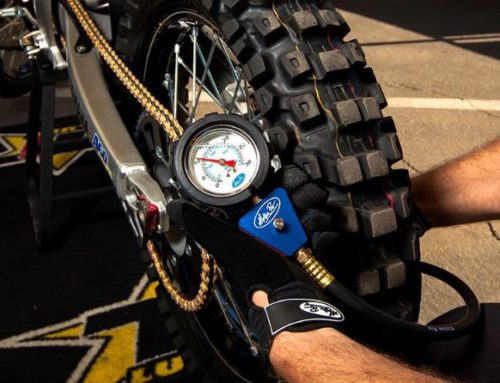Riding with the correct dirt bike tire pressure is the most important factor in tire maintenance and prolonging tire life.
How often do you check your tire pressures? Daily, weekly, or every time you ride? With dirt bikes, it is common practice to check them every time you ride.
With only two patches of rubber connecting you to the ground, keeping your tires in good condition and at the correct pressure is critically important.
Even small changes in tire pressure can affect your bike’s handling.
A change of 1 psi to a 10 psi tire pressure is a change of 10 percent, compared to say a car where a 1 psi change doesn’t make a huge difference in a 30 to 40 psi range.
Once you have selected your tire pressure, make adjustments in one psi increments, and if necessary go to half or even quarter psi increments.
Professional motocross teams make pressure adjustments of half or even a quarter psi, so that gives you an idea of how sensitive it can be in top-level racing.
General Dirt Bike Tire Pressure
A good rule of thumb for dirt bikes is 12 psi (pounds per square inch) in the front tire and maybe 12.5 in the rear tire.
That’s because for the vast majority of terrain you’ll be riding your tire pressure should be no lower than 8 psi and no more than 16 psi. 12 psi is the sweet spot in the middle, so its a good starting point to adjust up or down from there.
Effects of Improper Tire Pressure
The tire pressure you should be using depends on the riding conditions, the terrain type you’re riding and of course the type of tire you have fitted.
Check the tire’s service specs and your bike’s owner manual for the proper tire inflation.
Over or Under Inflation:
- causes irregular tread wear
- Tire or tube failure
Over Inflation:
- reduces the tire contact area with the ground
- reduces traction with the riding surface
Under Inflation:
- can cause the tire to not stay beaded on the rim
- affects the tire’s contact area with the ground and causes the tire to bow up in the middle and leaving the outer edges of the tread contacting the ground.
Benefits of Higher Tire Pressure:
- Reduces the chance of puncture, especially in rocky terrain
- Protects the rim from impacts
- Can achieve higher speeds on hard surfaces
- Better for carrying heavier loads or heavier riders
If you’re riding in terrain with lots of tree roots and square edge rocks then going up in tire pressure to 15-16 psi is advisable to minimize the chance of a pinched tube.
This is common in situations like trail or adventure riding where speed is not a major consideration, but not getting a flat is.
Benefits of Lower Tire Pressure:
- Better traction in soft conditions like sand, clay, or mud
- Good for riding Motocross tracks where you’re not going to hit sharp objects like tree roots or rocks
- Good for lighter weight riders
If you’re riding in soft terrain like loose dirt, soft clay, sand, or mud you will want to lower your tire pressure. This will increase your traction, but you are at a higher risk of pinching a tube, so a heavy-duty tube is recommended.
It’s a good idea to always use heavy-duty tubes (3-4mm thick) anyway, especially if you’re riding a lot of rocky or harsh terrain. 8 to 10PSI is about as low as you want to go.
Heat and Tire Pressure
Another factor to consider is the pressure once the tire heats up while riding. On mild days you may see not much of a change, but in 100 degree plus days, it could make a difference of a few pounds.
Sidewall flex, casing deformation, and wheelspin also increase the tire temperature. The rear tire tends to heat up more than the front due to friction.
In motocross racing, the rear tire may increase as much as six pounds in the rear and three in the front, so it’s best to go to the starting line with a lower pressure, say 10 psi so that the by lap three the tire will be at the correct pressure, approximately 14 psi.
What Is Rim Clean?
You may have heard this term in discussions on tire pressures. The sidewall of a tire tends to roll over the edge of the rim when riding.
A correctly inflated tire will flex and scrape the top edge of the rim clean, leaving a shiny strip of polished aluminum.
If you don’t see this shiny strip then your tire pressure is too high. If you see a strip more than 4mm wide, your tire pressure is too low.
Advocates of this method say it is the best way to see if you are getting the best traction, regardless of the type of tire and bike.
Rim Locks
Your bike should be fitted with rim locks, but if not you need to install them asap. They prevent your tire from spinning on the rim and tearing the tube’s valve out.
A telltale sign that your tire is slipping slightly is the valve stem is bent over forwards or backward.
If this is the case you need to deflate the tire and slip it around slightly till the valve is verticle, then reinflate the tire and retighten the rim locks.
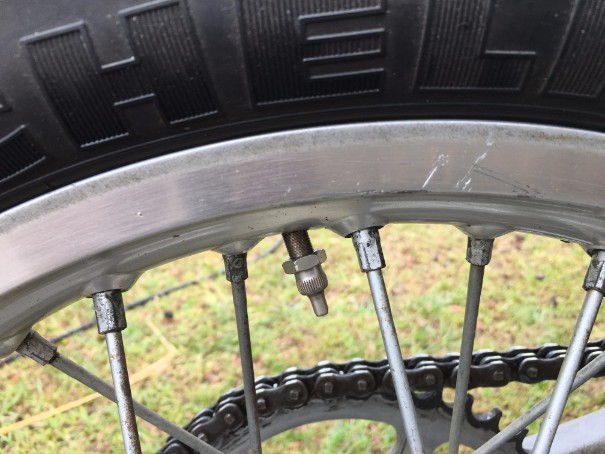
Tip: Tighten the valve stem nut up against the cap, not the rim otherwise you will have no warning when the tire is slipping on the rim, and rip the valve out straight away.
Foam Tire Inserts
Solid foam inserts commonly known as Mousse inserts give you a 100% chance of being puncture-free. They are sized to fit specific rim widths and tire sizes and give you the feel of a pneumatic tire inflated to one specific ‘pressure’.
Michelin introduced the Bib Mousse and remains the market leader. Goldentyre also offers their G-Mousse insert and several others are available.
The Bib Mouse retains the tire ‘pressure’ at 13 psi, so if you require a higher or lower psi, the inserts may not be to your liking.
The G-Mouse offers a 12-14 or 14-16 psi equivalent depending on the model.
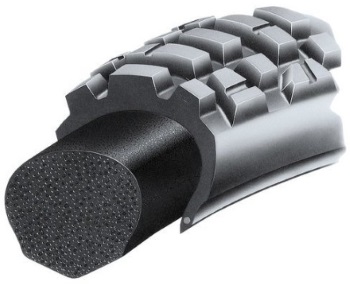
Mousse inserts are commonly used in extreme off-road terrain situations where you can’t risk a puncture. Enduro, desert racers and extreme enduro riders rely on them when trackside tire changes are not easily done.
They have a limited lifespan as the insert will break down and shrink over time and no longer fill the tire carcass cavity. This leads to the tire not keeping the bead seating and making the tube unusable.
The Mousse system also requires some maintenance. You need to regularly add lubrication. Installing them is also more difficult than conventional tubes.
A new Mousse supplier is Nuetech’s Nitro Mousse from the same company that developed the TUBliss System (below).
The TUBliss System
The TUbliss system is similar to the Mousse system in that it eliminates the need for a tube, but it allows pressure changes, unlike the Mousse.
It employs a dual pressure chamber system that replaces the conventional tube with a high-pressure, rim-protecting inner bladder which acts as a 360-degree rim lock that seals the tire to the full circumference of the rim.
The TUbliss rim protection acts as a 100 psi bumper which protects the rim against damage. The tire pressure used is most commonly in the 4 to 8 psi range, and as low as 0 on certain tires.
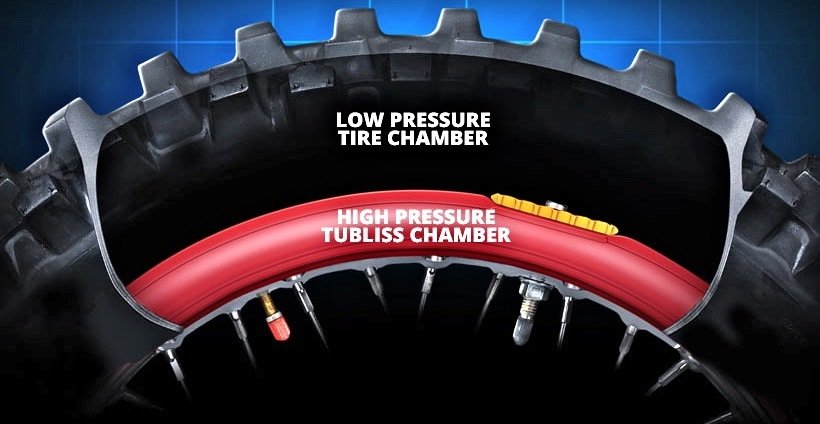
The main advantage over the Mousse system is the ability to adjust your tire pressure. The initial cost is higher than tubes, similar to the Mousse, and also more difficult to install than conventional tubes.
If you’re a rider that is always getting flats, you may want to consider the Mousse or the TUbliss options.
When you consider the cost involved, for a lot less money, the heavy-duty inner tube works well for most riders and has been around for decades.
Get A Decent Quality Tire Pressure Gauge
Because a motorcycle tire pressure is so much lower than a typical car tire pressure, you can’t use your car pressure gauge, it is not accurate enough. They are designed for readings of 30-50 psi.
You need a low-pressure tire gauge that is able to get a reading down to fractions of a psi. You can’t determine a variation between 11 or 12 psi on most automotive gauges.
One that is widely recommended is the Motion Pro Digital Tire Pressure Gauge. It gives a precise digital readout down to 0.1 psi and has a clear display with a backlight.
It’s also best to check your tire pressures at your riding destination and not at home the night before, as altitude and temperature changes can also have an effect on pressure.
As for tire pumps, you can use something as simple as a bicycle pump in most situations, and it will easily fit in your backpack.
Dirt Bike tires use a Schrader valve, which is the same kind of valve that you see on any car tire. Because the pressure is so low, it is easy to hand pump them.
When To Change Your Tires
It’s generally pretty easy to know when to change tires on your dirt bike.
When inspecting your tires look for the obvious signs of wear first:
- Rounded knobs
- Torn knobs or missing completely
- Cracking and discoloration
- Old tires which have hardened
Rounded knobs have lost that crisp, sharp edge. This will happen on the front edge of the knobs first, caused by acceleration.
When the knobs on the edge of the tires have also rounded, this will reduce your grip in the turns causing you to wash out.
Riding mostly on the road with tires that are designed for something like 10% street/90% dirt is the fastest way to wear out a knobby.

Tires harden with age after about one year. The worst thing you can do is leave them out in the sun. Cracked and discolored tires are usually the result of poor storage and/or age.
Some cracking is not so obvious. Check the base of the side knobs as this is a common area for cracking.
If you find it’s time to replace a tire it’s best to replace both tires together regardless of whether one looks better than the other. Typically the rear tire wears faster because it’s on the drive wheel.
Final Thoughts
Finding the right tire pressure for you may take a bit of trial and error, as every rider is different. Start with 12 psi and work your way up or down using the tips in this post.
Make small changes at a time till you find what works for you.
Just remember, lower tire pressures give better traction, but increased chance of a puncture, higher tire pressures reduce traction and can cause excessive wear, but reduced chance of a puncture.
Happy riding!
Related Posts
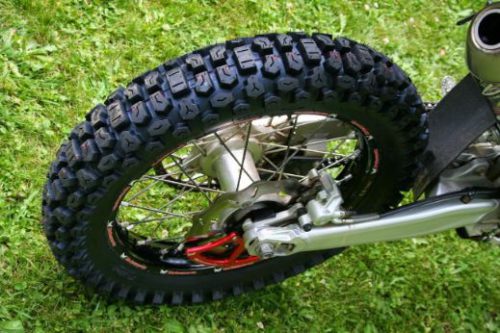 6 Best Dirt Bike Tires For Dual Sport Riding
6 Best Dirt Bike Tires For Dual Sport Riding
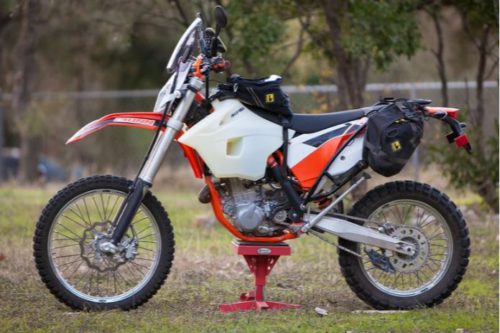
10 Best Dirt Bike Upgrades For Dual Sport Riding
What tire pressure is working for your particular riding style? Let us know your thoughts below.

